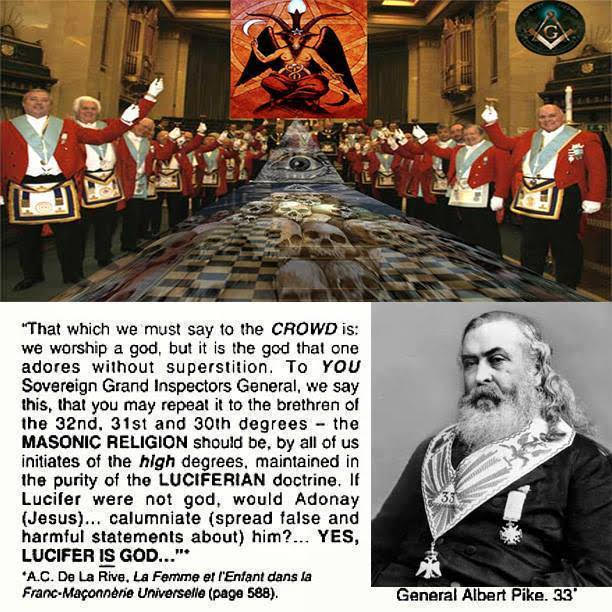TIMELINE OF WHY THE BRITISH FREEMASONS ARE NOT TRUSTED IN AMERICA
1825 CE: Captain William Morgan received the Freemason Royal Arch degree at Le Roy’s Western Star Chapter #33 and that same year Morgan announced he was going to publish an exposé titled Illustrations of Masonry, revealing the Freemasons secret higher degree details. Morgan was well-funded and had financial backers Publisher David Cade Miller, John Davids, and Russel Dyer—entered into a $500,000 penal bond with Morgan to guarantee its publication.

Lucifer SAYS WE ARE GODS and to be SELFISH — Albert Pike 33rd Freemason
Click here to see video in separate window: Click for Video
1826 CE: Assassination of Captain William Morgan (1774 CE-1826 CE), a captain in the War of 1812 against the British. The assassination ignited a powerful movement against the Freemasons, a fraternal society that had become influential in the United States. After Morgan announced his intention to publish a book exposing Freemasonry’s secrets, he was arrested on trumped-up charges. He disappeared soon after, and was believed to have been kidnapped and killed by Masons and dumped in the Niagara River. Morgan’s death sparked a public outcry and inspired Thurlow Weed and others to found the Anti-Masonic Party in opposition to Democrats. It is reported that half of the Masons in the region left the Freemason Lodge. Arrangements had been made to ship the planner and co-murderer, Richard Howard, a British Illuminati, back to England so he could not be tried with the rest of the criminals that were found guilty of kidnapping and other evil criminal activities.
1826 CE: Several Mason members of the Batavia New York lodge published an advertisement denouncing Morgan’s efforts saying the coming book violated the Mason’s oath of Secrecy. These Masons attempted to set fire to Miller’s newspaper office and print shop. Having local power these members on September 11, 1826 CE, arranged to have Morgan arrested for supposed nonpayment of a loan and allegedly stealing a shirt and a tie and in New York laws at the time allowed them to hold him in debtors’ prison until the amount was paid to stop him from publishing his book. When Miller learned of this, he went to the jail to pay the debt and secure Morgan’s release. Miller and Morgan then walked to a waiting carriage, which arrived the next day at Fort Niagara. It was soon after that Morgan was taken in a boat to the middle of the Niagara River, possibly killed, and thrown overboard as he was never seen again.
1827 CE: Captain William Morgan’s badly decomposed body washed up on the shores of Lake Ontario and the body was buried with his name on the grave. The Masons made up a story to cover their crimes about bribing Morgan to just go away and leave his family behind. Eventually, Eli Bruce, the sheriff of Niagara County and a Mason, was removed from office and tried for his involvement in Morgan’s disappearance; he served 28 months in prison after being convicted of conspiracy for his role in kidnapping Morgan and holding him against his will before his disappearance. Three other Masons, Loton Lawon, Nicholas Chesebro and Edward Sawyer, were convicted of taking part in the kidnapping, and served sentences. The Masons assassination of Morgan was never prosecuted due to a decomposed body which at that time could not be matched. The result was that anti-Mason sentiment caused many elections to go to non-Masons for a many years afterwards. Soon after Morgan disappeared, Miller published Morgan’s book, which became a bestseller that described the details of the Masons. The circumstances of Morgan’s disappearance and the minimal punishment received by his kidnappers caused public outrage, and he became a symbol of the rights of free speech and free press. Protests against Freemasons took place in New York and the neighboring states and all Masons were under a cloud of suspicion. The record of this is still in New York Archives.
1828 CE: John Quincy Adams denounced the Masons and in 1847 CE Adams published a widely distributed book titled Letters on the Masonic Institution that criticized the Masons’ secret society.
1830 CE: Morgan’s widow, Lucinda Pendleton Morgan, remarried a silversmith and moved to the Midwest.
1841 CE: Members of Freemasonry criticized the Mormons for their use of Masonic rituals and regalia.
1848 CE: Henry L. Valance confessed on his deathbed to taking part in Morgan’s “murder.” And the account of the assassination of Morgan is detailed in a book “The Character, Claims, and Practical Workings of Freemasonry (1869 CE) by Reverend C. G. Finney.
1882 CE: The National Christian Association openly opposed secret societies and commissioned and erected a statue in memoriam to Morgan in the Batavia Cemetery where Morgan was buried. The ceremony was witnessed by 1,000 people. The monument reads: “Sacred to the memory of Wm. Morgan, a native of Virginia, a Capt. in the War of 1812, a respectable citizen of Batavia, and a martyr to the freedom of writing, printing and speaking the truth. He was abducted from near this spot in the year 1826, by Freemasons and murdered for revealing the secrets of their order. The court records of Genesee County and the files of the Batavia Advocate, kept in the Recorders office contain the history of the events that caused the erection of this monument.”
Source Article from https://concisepolitics.com/2018/04/07/timeline-of-why-the-british-freemasons-are-not-trusted-in-america/
 RSS Feed
RSS Feed















 April 7th, 2018
April 7th, 2018  Awake Goy
Awake Goy  Posted in
Posted in  Tags:
Tags: 













